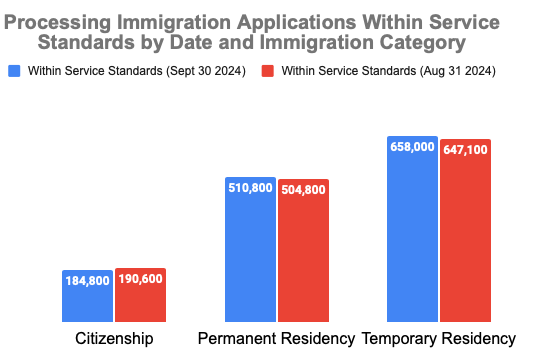How bad is Canada's immigration system?
As Canada sets out its latest immigration targets, new data shows that over 1 million applications are currently in backlog. Here's 3 things you should know heading into 2025.
Immigration processing in Canada is bad. Like….really, really bad.
Pictured: Federal Immigration Minister, Marc Miller.
The latest data released earlier this month shows that there were more than one million applications in backlog, as of September 30.
I’ll say that again.
Over 1 million applications in backlog.
But while many outlets have lazily latched onto this single number, I’m offering a more nuanced analysis. In essence: there’s good news… and there’s bad news.
Let’s look at the 3 key insights I found when looking at the data.
1) Immigration Backlogs Continue to Grow — Especially for PR and Temporary Residence Applications
It seems that that the immigration backlog continues to grow, especially for the larger volume streams of Permanent Residency (PR) and Temporary Residency (which includes study permits and skilled workers).
In total, we’re looking at 1,078,300 applications in backlog, a slight increase of nearly 2% since the previous month.
Not bad, but it’s trending in the wrong direction.
2) Slight Increase in the Number of Applications Being Processed Month-to-Month
Second, we’re also seeing a slight increase in the volume of applications being processed by IRCC, especially in the PR and Temp. Residency streams.
Note the inverse trend compared with backlogs. What’s interesting is that it also corresponds with the large immigration pathways (ie PR and temporary residency). Why? I have some ideas (below).
3) The proportion of applications in backlog varies depending on type of immigration category
Third — and here’s where it gets weird — the proportion of applications in backlog has decreased in several categories (eg Citizenship, Provincial Nominee, Work Permits), but conversely increased for more in-demand categories (eg Temporary Resident visas, Express Entry, Study Permits).
What this seems to suggest to me is that programs which have recently been tweaked by the federal government (eg recent cuts to Study Permits, new categories of Express Entry draws, etc) may have slowed down processing speeds, while other “more stable” immigration categories (eg citizenship, work permits) have seen processing efficiencies either stabilize or increase.
4) Overall, both immigration processing and backlogs have increased since last year
Here’s a good visual I put together showing the change in application backlogs and those currently being processed.
Over the past year, backlogs have increased 18.2%, while applications in processing have likewise grown 11.7%.
Given the recent fluctuation in announcements (eg Jan 2024 cap on study permits), you might expect that to radically alter the landscape). But when all immigration streams are merged together, those differences in program eligibility changes more or less evaporate.
Conclusions
Given the last year of turbulent announcements — from sudden caps on international students to new Express Entry categories — it is unsurprising to see decreased processing speeds for certain immigration streams (eg Express Entry and Study Permit applications) — especially as IRCC application officers struggle to keep up with all the changing regulations.
The lesson here is: festina lente ie. “make haste slowly”. In other words, immigration should be tweaked on an ongoing basis with minor adjustments, similar to how the Bank of Canada makes periodic, minuscule adjustments to interest rates.
If immigration was about driving a car — instead of paying attention to the road, the federal government has been absently looking outside at the birds flying by, then wildly swerving right before hitting the guardrail. If you continue to wait long periods and then make sudden, drastic changes to immigration program criteria and metrics — expect it will clog up the system with more application backlogs.
And once the federal government finds out that it wants to turns the taps back on (e.g. to help save Canada’s negative population growth), the backlogs will be too jammed up for anything to flow.












